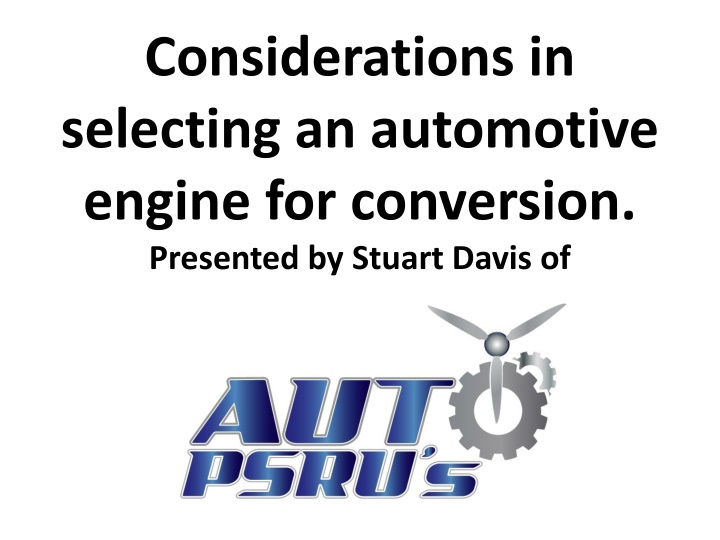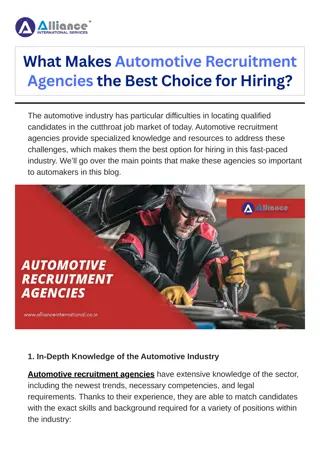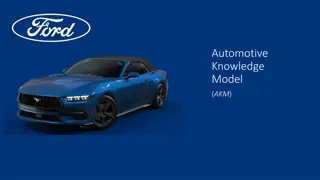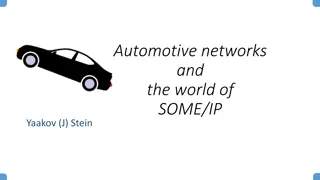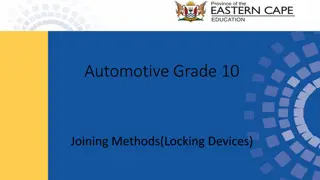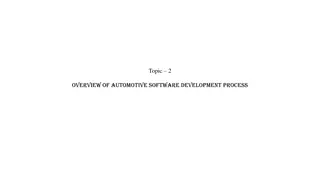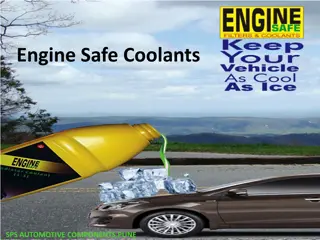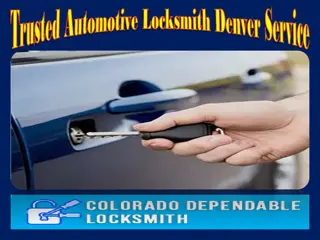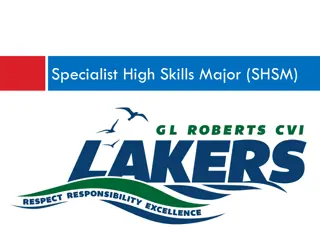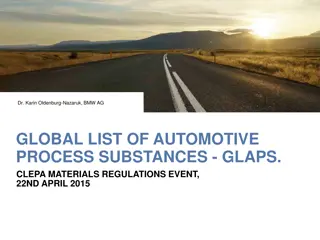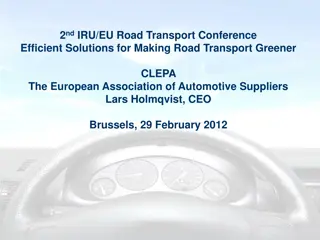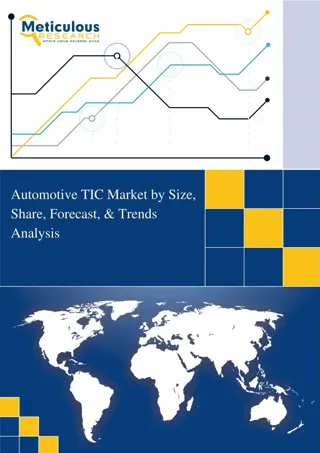Considerations in Selecting an Automotive Engine for Conversion
Stuart Davis discusses important aspects to consider when selecting an automotive engine for conversion, including propeller restrictions, engine selection and performance, gear ratios, fuel chemistry, FAA requirements, and more. The presentation covers factors such as maintenance costs, aftermarket support, service history, and long-term engine support. Various engine options and their performance characteristics are also highlighted to help in making an informed decision.
Download Presentation

Please find below an Image/Link to download the presentation.
The content on the website is provided AS IS for your information and personal use only. It may not be sold, licensed, or shared on other websites without obtaining consent from the author.If you encounter any issues during the download, it is possible that the publisher has removed the file from their server.
You are allowed to download the files provided on this website for personal or commercial use, subject to the condition that they are used lawfully. All files are the property of their respective owners.
The content on the website is provided AS IS for your information and personal use only. It may not be sold, licensed, or shared on other websites without obtaining consent from the author.
E N D
Presentation Transcript
Considerations in selecting an automotive engine for conversion. Presented by Stuart Davis of
ISSUES YOU HAVE TO CONSIDER Propeller Restrictions Engine Selection & Performance Gear Ratio s and Types of Drives Fuel and Oil Chemistry FAA Requirements Questions and Answers
ENGINE SELECTION 1) Choose a previously converted and proven engine, like a VW, Corvair, or Chevy V8. Find out what has worked and what has not worked for you airframe and goals. 2) Use your favorite engine, but watch for; a) Cost of maintenance parts b) Aftermarket parts and support performance and heavy duty parts, electronics - is it possible to get the EFI and/or ECU reprogrammed? 3) Is there a known service history, and will there be long term support for the engine. 4) Are you falling into the BUBA J trap over an engine?
ENGINE PERFORMANCE Must be compatible with Propeller Limitation Dyno Chart for Horsepower and Torque RPM ranges Need a gear ratio to get from Propeller to Engine RPM s For GM LS V8 engines the BW350 gear ratio is 1.667:1 RPM limit for stock GM crate engines is 6000 RPM. Safe continuous RPM at 75% of limit is 4500 RPM. 4500 RPM / 1.667 = 2700 RPM Which engines look good at 2500 to 4500 RPM? 5.7L to 6.2L LS V8 s replace IO-540 and IO=550 The 4.3L V-6 will make a good alternative for the IO-360 and IO-390.
LS1 5.7L DYNO CHART 4500 RPM = 310 HP & 375 (380 peak) Torque $5,924
LS7 7.0L DYNO 4500 RPM = 396 HP & 460 Torque vs 310/375 * about 45# heavier and $17,129 more
LS9 6.2L SC DYNO 4500 RPM = 290 HP & 380 Torque $26,010
LS3 6.2L DYNO 4500 RPM = 367 HP & 427 Torque vs 310/375 SRP = $7,761
LS3 ENGINE TO PROP POWER Cruise
GEAR RATIOS / TYPES OF DRIVES Two basic types of drives Geared and Belted Belted Drives 1) Are lighter but are limited to about 250 HP 2) Don t support constant speed propellers 3) Gear ratios typically are 1.43 thru 3.00 to 1 Geared Drives 1) Are heavier but handle 200 HP and up 2) Required lubrications system can easily support constant speed propellers 3) Gear ratios typically are 1.23thru 3.53 to 1 Both have vibration dampening challenges.
GEAR RATIOS / TYPES OF DRIVES Vibration Dampening Auto PSRU s uses this design on both the 200Z and BW350
BW350 Gear Box PSRU for Chevrolet LS series engines, V8, V6, I4 400+ Horsepower Clutch engages/disengages at about 900 RPM Straight cut gears more efficient, reduced loads Uses automatic clutch and dynamic damper Much lighter loads on starter Eliminates Propeller Kick-back Independent lubrication system Gear Ratio 1.667:1(fixed due to shaft spacing) WEIGHTS: Gear Box = 63 lbs (w/o prop gov., about 2 lbs) Clutch Assy = 37 lbs Lubricant = 4 lbs TOTAL = 106 lbs
Fire Wall Forward Comparisons FWF weights vary depending on the aircraft installation due to motor mounts, radiator installations, cowling mods, arrangement of accessories, type of exhaust, etc. On the Glasair III the LS1 FWF installation weighed just under 30 lbs less. On the Raven 500 with the LS1 weighing 22 lbs less. (less propellers and cowlings) ADVANTAGES 1) Costs; purchase and maintenance. 2) Cabin Heat; through a water heater eliminates carbon monoxide. 3) Alternators; 85 - 205 amp on the LS1 vs 35 - 65 amp on an IO-540. OPTIONS FOR THE WEIGHT SAVINGS 1) Factory A/C that runs off the engine rather than off the electrical system. 2) Add an engine pre-oiler system, 3) Electrical systems; a backup alternator, a backup battery.
Why The Buzz Over Crate Engines? #1 Insurance companies at first did not offer insurance for the first 40 Hours Phase 1 flight testing unless it is a factory built engine. Positive experience is starting to relax some of these requirements. Check with your insurance and/or compare requirements. #2 Some factory crate engines are not intended to be operated continuously under the higher load conditions we subject them to. Selecting the correct one with stronger connecting rods and crankshafts is important. #3 These engines are different and have some unique requirements for assembling one correctly. There are several good books and videos on how to do it. Done correctly a wide variety of stronger parts and even better dyno performance curves are possible.
RADIATOR SIZING Basic minimum size calculation for any water cooled engine is 1.2 times the Horse Power of the engine equals the radiator area in square inches. 350 HP engine x 1.2 = 420 sq in core area (dual row core). Dual radiators = 420 / 2 = 210 sq in core area for each radiator. Dual radiators requires a header tank mounted higher than the radiators in addition to an overflow collection tank. Adding extra rows of cooling tubes to a radiator core does not increase the cooling capacity of the radiator in a linear fashion. If you start with a 120 sq in single row core a 60 sq in dual row core will not cool as well, and a 40 sq in 3 row core will cool even less. Each additional row reduces the total air flow threw the core due to increased aerodynamic drag. Pure water does conduct heat better than water mixed with antifreeze. The advantage of is to lower the freeze pint, it does help to raise the boiling point slightly, but most importantly it prevents corrosion and lubricates the water pump bearings and seal.
INTAKE INDUCTION REQUIREMENTS Quoted from the GM installation manual for crate engines. Ensure the MAF sensor is oriented correctly in the induction (it will only read correctly in the proper direction). An arrow is located on the sensor indicating correct flow direction. Verify this before welding the mounting boss, as the sensor will mount only one way in the boss. Ensure the MAF Sensor is mounted in the middle of a minimum 6 inch length of 4 inch diameter tube, and is a minimum of 10 inches from the throttle body. All current GM crate engines use a MAF Sensor between the air filter and the throttle body. The MAF Sensor accuracy is greatly effected by any turbulence before and after the sensor. The changing position of the throttle body valve plate will cause the pressure wave ahead of the throttle body to change location up and down the tube. The extra 4 inches in total tube length can include the elbow fitting.
INTAKE INDUCTION REQUIREMENTS Minimum 6 Straight Section 4 To Air Filter Tube Air Flow Minimum 10 From Throttle Body UP
200Z Gear Box PSRU for engines 100 to 300 Horsepower Clutch engages/disengages at about 900 RPM Straight cut gears more efficient, reduced loads Uses automatic clutch and dynamic damper Independent lubrication system Much lighter loads on starter Eliminates Propeller Kick-back Gear Ratios of 1.506:1 to 3.529:1 (std shaft spacing & 2 sets of gears) WEIGHTS: TOTAL = 70 lbs Gear Box = 39 lbs (w/o prop gov., about 2 lbs) Clutch Assy = 28 lbs Lubricant = 3 lbs 2 lbs less than Eggenfellner
200Z INSTALLATIONS The 2.5L Four Cylinder Subaru replaces Lycoming 235 or 320 The 3.6L Six Cylinder replaces Lycoming 320 or 360 (2.16:1 to 2.28:1 is standard) Dual sets of gears provides over 145 possible gear ratios between 1.506:1 and 3.529:1 Gear Ratio flexibility means it will also be good to use on Mazda 13B and 20B Rotary engines
SUBARU DYNO CHART 4 Cylinder 6000 engine RPMs @ 2.179:1 = 2754 RPMs at the Propeller
SUBARU DYNO CHART 6 Cylinder
GEAR RATIOs The BW350 only comes in one gear ratio. As shown earlier, this drives the engine requirements . The 200Z comes in many gear ratios. So things like propeller choice, turbo or naturally aspirated, airframe, and performance goals can be used to tailor the gear ratio that achieves the best compromise. Because the 200Z has a zero vertical offset from the crankshaft it works well with flat opposed engines like the Subaru 4 & 6 cylinder engines. Calculations and flight testing has shown that 2.16:1 to 2.28:1 ratios covers 90% of these installations. It will also work well with Mazda Rotary engines. These engines turn up to 8000rpm and require gear ratios in the 2.91:1 to 3.03:1 range The WWI Replica s also like it for adapting Ford and Chevy inline 6 engines. Due to the large diameter wooden propellers they also require about 1.91:1 gear ratio.
FUEL and OIL CHEMISTRY Synthetic engine oil is not compatible with leaded fuels! If you are always, 100%, going to use auto unleaded gas then any of the synthetic engine oils will work fine. If you run any 100LL Avgas you can not use synthetic engine oil. Synthetic engine oils can not disperse the lead additives and by products they produce in the combustion cycle. These turn into a thick gray sludge that quickly accumulates in the bottom of the oil pan which will restrict oil from being pulled into the oil pump and cause lubrication failures.
FAA REQUIREMENTS Wiring Harness Change from Nylon & Vinyl to all Teflon insulated wire. Teflon has increased melting and burn temps Nylon & Vinyl out gases deadly toxins like fluorine gas Currently this is the only FAA required change that we have run into. Some FSDO s and inspectors encourage using an oil filter that can be safety wired.
Other Information Coil Pack Fuses one for each individual coil pack Factory wire harness uses one fuse for all 8 coil packs Dual ECU s A/B switch (probably not needed) Dual Spark Plugs? will run as an I-4 (all 4 in one bank) or on just 3 cylinders across both banks. (not needed) Mechanical Throttle Body this required by the CAA in Canada. Only aftermarket ECU s will support these. Diesels? 10K alt limit but Jet A fixes that, weight and torsional vibrations are much higher. Diesel fuel and Jet A is more common in 2nd and 3rd world countries
Auto PSRUs Home Page www.autopsrus.com
CONTACT INFO Website: www.autopsrus.com email: stuart@autopsrus.com Phone: (936) 827-5126 email: blank subject = delete (spam or security risk)
QUESTIONS & ANSWERS EXCLUSIONS: Politics Taxes Weather Religion
